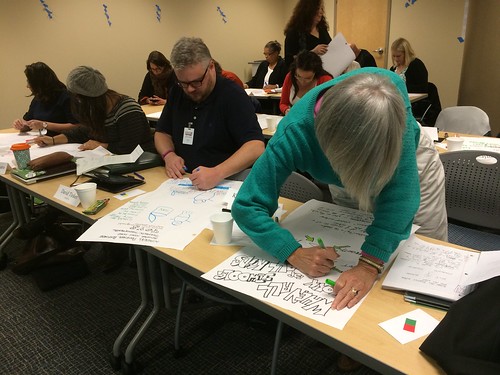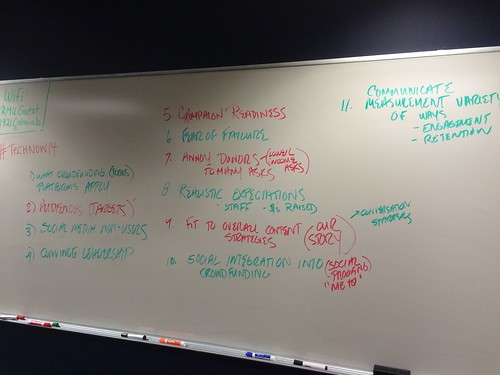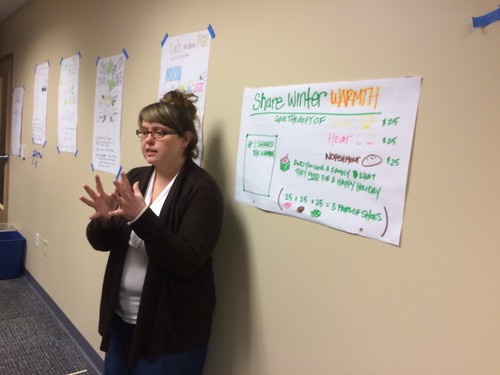
Last week, I was honored to facilitate a workshop on best practices in crowd funding in Pittsburgh, PA organized by The Bayer Center for Nonprofit Management at Robert Morris University in conjunction with its TechNow Conference (where I delivered the keynote). I’ve already shared a blog post about the content related to “Best Practices for Nonprofit Crowd Funding” that includes case studies, examples, tips, and resource links. Instructional design is more than just delivering the content, so this post shares some of the thinking that went into designing a learning experience where people will apply what they learned.
As a trainer and subject matter expert, I fight a big battle when designing a workshop. Balancing the amount of content delivery with exercises and right sizing given the available time for the workshop. Given how busy nonprofit professionals are, most face-to-face workshops are typically a half-day and sometimes a whole day. That means you have approximately 3 hours and the whole time should not be spent lecturing with a PowerPoint deck! I believe that workshops are an opportunity for nonprofit staffers to have some “thinking time” — to reflect and think about how the content applies to their specific situation.
The learning objectives for the workshop were two fold:
- Participants understand best practices and how to apply
- Develop a first draft of a crowd funding strategy for their organization

While I did a pretty thorough participant assessment survey before finalizing the content, the instructional design and creating materials, I always like to get a group understanding of the learning goals and get people ready to learn. Here I used a classic, simple technique of asking people to share burning questions in small groups and generated a list of the themes/questions with the full group. I’m always relieved when the questions match the content, but you also have to point out where you will go deep and what may not be addressed. (Always good to leave time for Q/A at the end for those).
The content focused on telling a couple of “campfire” stories with insights about best practices. This section was followed by taking people through a worksheet that breaks down the step by step of thinking through a campaign – both examples and small group or individual exercises. This was the first 90 minutes of the workshop, and while content and interaction kept in active learning mode — the next step was a synthesis.
This where design thinking methods and innovation lab facilitation techniques can be helpful. I thought the most helpful synthesis task would be a “design rationale.” If crowd funding is a new idea or innovation for an organization, it can fail to become a practice simply because the participant is not able to convey the concept’s full potential. So, while participants could have taken great notes and reported back to others at their organizations, having those notes plus being able to articulate a concept of how their organization implement a crowd funding campaign might just have a better chance of implementation back at the office.

I opted for a human centered design technique called “Concept Poster,” a presentation format that illustrate the main points of a new idea. The format of the concept poster was more open then the close-ended set of exercises and questions on the worksheet. They need a tagline, illustration, key points, and additional detail. The concept poster can help someone synthesize their ideas, but they also have to be able to explain it to others – both visually and verbally. So, I gave participants quiet time to work a concept poster and time for rapid presentations of the posters.


The Concept Posters are also the artifacts of learning! First, if the participant takes their poster, notes, and worksheets, they can go back to their organization and share their ideas with others. It can be the first campaign strategy session. Second, being a data geek – these artifacts of learning can help me assess participant understanding of the concepts of crowd funding – and how to improve the content for better understanding.
Since I’m still iterating on this workshop, I also incorporated a simple verbal feedback exercise at the end. While you also want to always do an evaluation survey so you can quantify the participant’s assessment of their learning and feedback, I find verbal feedback is like doing a mini-focus group – getting feedback from participants right afterwards is always extremely valuable. I got some fantastic ideas for modifying the content and exercises and timings.
The technique I use for getting verbal on a workshop is to ask what would participants keep, change, or delete? You have to avoid being defensive and remain neutral, especially if you hear that something you thought was brilliant was not perceived by participants as brilliant. You have to listen to every comment and accept it as a gift with enthusiasm and a smile. That is hard to do but a good professional skill in many other contexts than training. Here are some tips.
If you feel that you might have a hard time not getting defensive or you have time for a more in-depth debrief, you can do a written exercise and ask participants to reflect on what they learned and how they will apply it. To do this analysis, you need to ask for both positive and constructive criticism. The technique is called Plus/Delta.
Here are some examples of the questions you can ask adult learners to write down and then discuss in small groups. You can also handout index cards and ask people to write “positives” on one side and “please change” on the other. Or, have them fold 8 x 11.5 paper into quarters, number the spaces, and answer the questions or draw pictures.
- What really struck you as interesting, new, provocative, or meaningful during this workshop?
- What is one change that you can make in your practice or one idea that you will put into practice as a result of this workshop?
- What part of the workshop was most useful to your work?
- What part of the workshop should be changed to improve learning?
You can ask people to share it anonymously. Sometimes I ask them to include their names and I do a drawing for a free book during the learning culmination exercise (see below.) After the session, I spend a few hours doing an analysis of what people wrote on the cards and use it to review with my lesson plan.
Incorporating exercises and ways for participants to have some thinking and synthesis time in your work can help improve the learning and subsequent application. Also, if you want to get better at being a trainer, you need to get feedback from your participants. While evaluation surveys are great, they are only one form of feedback.
How do you incorporate ways for participants to synthesize their learning? How do you get feedback from participants to improve what you’re doing? Share your story in the comments.
